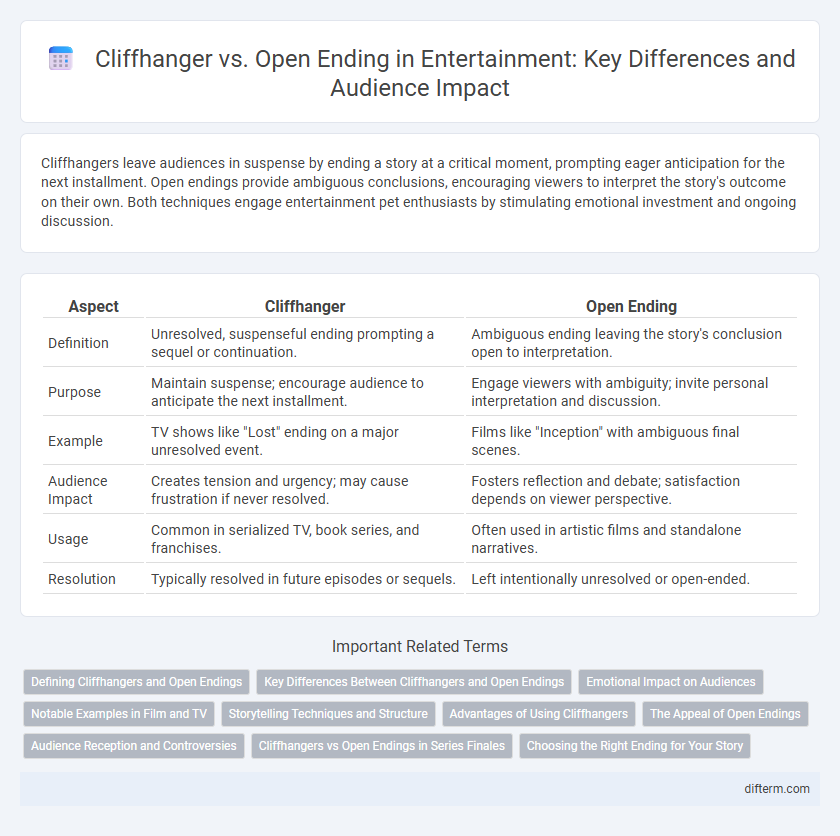Cliffhangers leave audiences in suspense by ending a story at a critical moment, prompting eager anticipation for the next installment. Open endings provide ambiguous conclusions, encouraging viewers to interpret the story's outcome on their own. Both techniques engage entertainment pet enthusiasts by stimulating emotional investment and ongoing discussion.
Table of Comparison
| Aspect | Cliffhanger | Open Ending |
|---|---|---|
| Definition | Unresolved, suspenseful ending prompting a sequel or continuation. | Ambiguous ending leaving the story's conclusion open to interpretation. |
| Purpose | Maintain suspense; encourage audience to anticipate the next installment. | Engage viewers with ambiguity; invite personal interpretation and discussion. |
| Example | TV shows like "Lost" ending on a major unresolved event. | Films like "Inception" with ambiguous final scenes. |
| Audience Impact | Creates tension and urgency; may cause frustration if never resolved. | Fosters reflection and debate; satisfaction depends on viewer perspective. |
| Usage | Common in serialized TV, book series, and franchises. | Often used in artistic films and standalone narratives. |
| Resolution | Typically resolved in future episodes or sequels. | Left intentionally unresolved or open-ended. |
Defining Cliffhangers and Open Endings
Cliffhangers create suspense by leaving a story unresolved at a critical moment, compelling audiences to anticipate the next installment. Open endings, in contrast, provide ambiguous or incomplete conclusions that invite viewers to interpret the narrative's outcome independently. Both techniques enhance engagement but differ in intent: cliffhangers drive immediate curiosity, while open endings encourage lasting reflection.
Key Differences Between Cliffhangers and Open Endings
Cliffhangers create suspense by leaving the narrative unresolved at a critical moment, compelling audiences to anticipate a sequel or continuation. Open endings provide ambiguity without a definitive conclusion, encouraging viewers to interpret the story's outcome independently. Both techniques engage the audience but differ in intent: cliffhangers drive future installments, while open endings emphasize thematic depth and subjective interpretation.
Emotional Impact on Audiences
Cliffhangers intensify emotional engagement by creating suspense and uncertainty, compelling audiences to eagerly anticipate the resolution, which can heighten feelings of excitement and anxiety. Open endings invite personal interpretation, fostering emotional reflection and deeper connection as viewers construct their own conclusions. Both narrative choices effectively evoke strong emotions but differ in delivering closure versus ambiguity.
Notable Examples in Film and TV
Notable examples of cliffhangers include the final episode of "The Sopranos," which left Tony Soprano's fate ambiguous, and "Breaking Bad" season finales that often ended with intense unresolved moments. Open endings are exemplified by films like "Inception," where the spinning top leaves the reality of the dream world uncertain, and "Lost in Translation," which concludes with an enigmatic farewell. These storytelling techniques heighten audience engagement by provoking speculation and debate long after the narrative concludes.
Storytelling Techniques and Structure
Cliffhangers heighten suspense by leaving critical plot points unresolved, urging audiences to anticipate a sequel or continuation, while open endings provoke reflection by allowing multiple interpretations without clear resolution. Both storytelling techniques manipulate narrative structure to affect emotional engagement and thematic depth, with cliffhangers often integrated at pivotal moments and open endings concluding the story ambiguously. Effective use of these devices depends on genre conventions and the creator's intent to balance closure with intrigue, enhancing audience investment and narrative complexity.
Advantages of Using Cliffhangers
Cliffhangers effectively heighten audience engagement by creating suspense that encourages viewers to return for subsequent episodes or sequels. This narrative technique maintains momentum and fosters emotional investment, enhancing overall storytelling impact. Using cliffhangers can also boost social media buzz and anticipation, driving increased audience interaction and retention.
The Appeal of Open Endings
Open endings captivate audiences by sparking curiosity and encouraging personal interpretation, which deepens engagement with the narrative. Unlike cliffhangers, open endings provide unresolved thematic questions that invite viewers to reflect on character motivations and potential outcomes. This storytelling technique enhances emotional resonance and fosters ongoing discussions within fan communities and critical analyses.
Audience Reception and Controversies
Cliffhangers often generate intense audience engagement by creating suspense and prompting speculation, leading to strong fan debates and social media buzz. Open endings elicit diverse reactions, with some viewers appreciating the ambiguity and others expressing frustration over unresolved narratives, sparking controversy over narrative satisfaction. Both techniques influence audience reception by shaping emotional investment and polarizing opinions on story closure in films and television series.
Cliffhangers vs Open Endings in Series Finales
Cliffhangers in series finales create suspense by leaving key plot points unresolved, encouraging viewers to speculate about future developments and maintain long-term engagement. Open endings, in contrast, provide ambiguity without clear resolution, allowing audiences to interpret the conclusion based on personal perspective and thematic depth. The choice between cliffhangers and open endings impacts fan satisfaction, narrative closure, and potential for spin-offs or continuations in entertainment series.
Choosing the Right Ending for Your Story
Choosing the right ending for your story hinges on the impact you want to leave on your audience; cliffhangers create suspense by leaving key plot points unresolved, driving anticipation for sequels or discussions. Open endings encourage viewers to interpret and imagine, fostering deeper engagement and personal connection with the narrative. Assess your genre, target audience, and long-term storytelling goals to determine whether a cliffhanger or an open ending best complements your narrative style.
cliffhanger vs open ending Infographic

 difterm.com
difterm.com